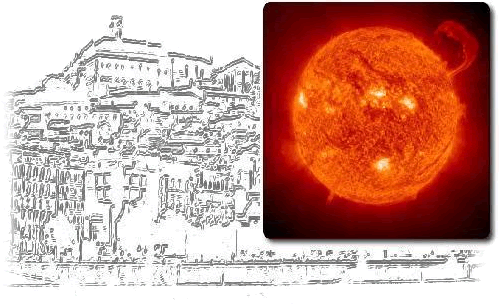|
|
|
|
|
|
|
|
|
|
|
|
|
Pavol Schwartz, Mr. - Dr. |
|
Astronomical Institute, Slovak Academy of Sciences, Tatranská Lomnica, Slovakia |
|
|
|
|
|
|
|
Session 3 - Poster |
|
Non-LTE inversion of spectropolarimetric and spectroscopic observations of a filament on 11 September 2014 at the VTT |
|
P. Schwartz (1), H. Balthasar (2), C. Kuckein (2), J. Koza (1), P. Gömöry (1), J. Rybák (1), A. Kučera (1), P. Heinzel (3); 1 - Astronomical Institute, Slovak
Academy of Sciences, Tatranská Lomnica, Slovakia; 2 - Leibniz Institut für Astrophysik, Potsdam, Germany; 3 - Astronomical Institute, Academy of Sciences of the Czech Republic, Ondřejov, Czech Republic |
|
|
|
A filament in the active region NOAA 12159 (at solar disk coordinates
[x,y] = [225,-440] arcsec) was observed with the Vacuum Tower Telescope at Tenerife
on 11 September 2014. Full-Stokes spectropolarimetric observations in the HeI IR
triplet at a wavelength around 10830 Å and the SiI 10827 Å line were performed using
the Echelle spectrograph together with the Tenerife Infrared Polarimeter (TIP).
Additional spectroscopic observations in the CaII 8542 Å line were obtained with the
spectrograph. With the TESOS Fabry-Perot interferometer,
the filament was observed in H_alpha in intensity mode with a field-of-view of 25 x
25 arcsec (136 wavelength points within the range 6561 - 6564 Å). Magnetic
structure and properties of the photospheric plasma in the vicinity of the filament
were inferred from the SiI 10827 Å line using the Stokes Inversion using Response
function code (SIR; Ruiz Cobo & del Toro Iniesta 1992, Bellot Rubio 2003). From the
HeI Stokes profiles a horizontal magnetic field of around 160 G was inferred in the
filament using the Hanle Zeeman Light inversion code (HAZEL; Asensio Ramos, Trujillo Bueno
and Landi Degl'Innocenti 2008).
The filament showed no activity in the CaII 8542 Å absorption profiles (no central
emission, no high velocities). Therefore it was possible to use the 2D non-LTE model
of a quiescent filament to simulate the H_alpha profiles obtained from TESOS to
diagnose the filament hydrogen plasma. In this non-LTE model, the same
magneto-hydrostatic structure of Kippenhahn-Schlueter type was used as in the
non-LTE 2D prominence model of Heinzel and Anzer (2001). |
|
|
|
|
|
|
|




 









 |



